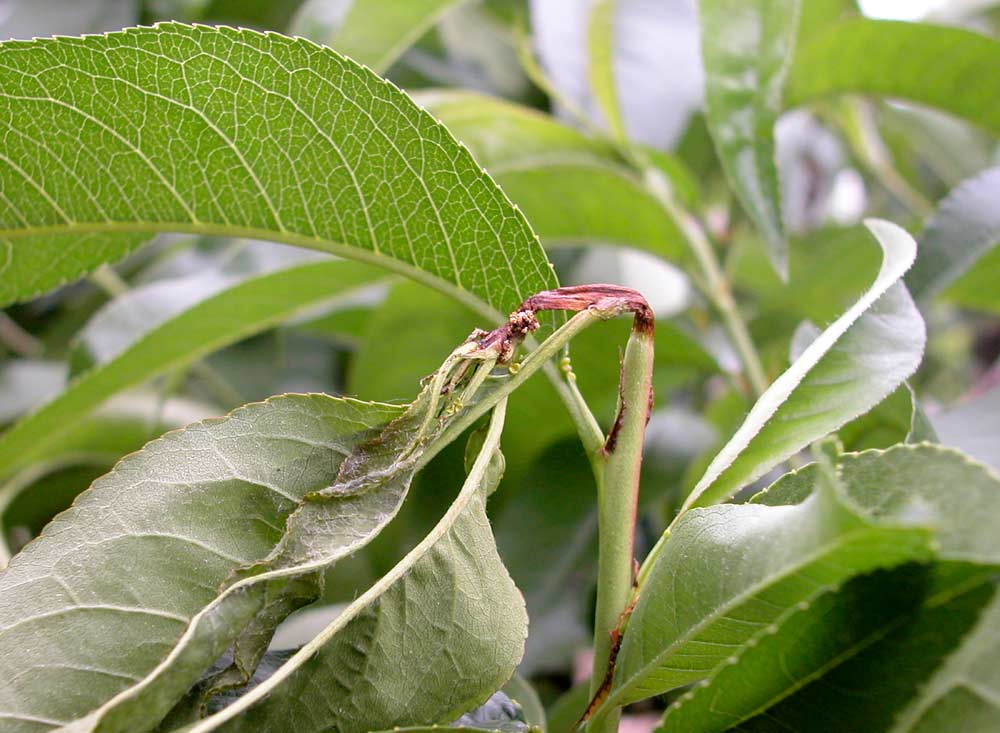
Monitoring the population of oriental fruit moths (OFM) in an orchard can be difficult when OFM mating disruption is used, especially when the monitoring lures rely on pheromones to draw the pest. New research, however, shows good capture rates of OFM (shown here) with a lure that combines pheromones and plant components.
(Photo by Greg Krawczyk)
Growers who use mating disruption for oriental fruit moths now have a lure that effectively monitors the pests, according to new research.
Using a combination of pheromones and plant components, the new lure successfully attracts adult male and female oriental fruit moths, which have proven to be elusive in the past, said Greg Krawczyk. He is extension tree fruit entomologist and research associate professor of entomology at Penn State University and its Fruit Research and Extension Center. “This is something we’ve never had before,” he said.
With mating disruption, growers may use as many as 200 pheromone-emitting dispensers per acre to distract males from females, thereby greatly reducing reproduction and the overall population. They primarily use pheromone-based monitoring lures that draw in and trap the moths to monitor how well their efforts are working and determine if they need to take additional action.
Unfortunately, Krawczyk said, those monitoring traps are not always good gauges of moth populations in treated orchards using mating disruption. “Even when we weren’t catching anything in those traps, which we took as a good sign that mating disruption was working, we were still sometimes finding fruit injured by oriental fruit moths in these orchards, so (it was clear) that the traps were not effective enough.”

The invasive moths also attack peach trees, as illustrated in this damaged shoot. (Photo by Greg Krawczyk)
The discrepancy between perceived and actual numbers of moths arises because these monitoring lures and mating-disruption dispensers use the same pheromones, he said, “so the whole orchard is saturated with the same pheromone. As a result, the monitoring lures are not attractive to oriental fruit moths and they catch nothing.” He also noted that the pheromone only draws in males, so these monitoring lures don’t pick up females.
At first, Krawczyk and other researchers tried using a higher dose of pheromones in the monitoring lures, but without success. Then, building on work by entomologist Alan Knight from the U.S. Department of Agriculture’s Agricultural Research Service lab in Yakima, Washington, the researchers began adding other components to the standard sex-pheromone lures and evaluating these options in both apple blocks and peach orchards.
In lure evaluations conducted in 2015, 2016 and 2017 at the Penn State Fruit Research and Extension Center, as well as in growers’ orchards, Krawczyk’s group showed that these enhanced lures could catch oriental fruit moths in mating disruption-treated orchards. This work was funded with support from the State Horticultural Association of Pennsylvania. Similar studies conducted by North Carolina State University entomologist Jim Walgenbach showed almost identical results, Krawczyk said.
Findings of the studies also indicated that one lure for oriental fruit moths was especially effective in catching adult males as well as females in orchards that use mating disruption, and when compared to traditional pheromone-only monitoring lures, it also caught higher numbers of adults in orchards without mating disruption, Krawczyk said. Called TRE-1123, this lure is made by Trécé Inc. of Adair, Oklahoma, (commercially available as Pherocon OFM Combo Dual as of spring 2017), and has a proprietary blend of pheromones and plant extracts. “With this lure, we can finally monitor oriental fruit moth adults in orchards that use mating disruption,” he said. “It will provide information about moth pressure, tell growers if any corrective treatments are needed, and help them manage their orchards better.”
The next step in the research will be to compare capture numbers between pheromone-only lures and TRE-1123, because current thresholds for moth management are based on the lower numbers of moths caught in pheromone-only lures. “We’ll have to reevaluate those recommendations, but to do that, we have to gain some more experience with this new lure and develop some valid correlations.” •
—by Leslie Mertz






Leave A Comment